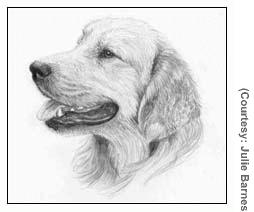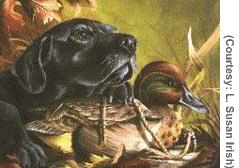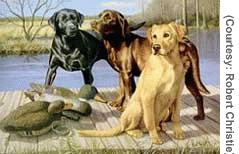|
Getting started: Animal art
|
 |
May 28, 2001: 12:15 p.m. ET
Starving artists need not go hungry; pet owners are where the work is
|
NEW YORK (CNNfn) - By now, it may be common knowledge that pet owners are often more attached to their pets than just about any other living creature on the planet and are willing to spend unthinkable sums of money to pamper their precious pooches.
So it should come as no surprise that animal lovers are also willing to spend good money to commission portraits of their beloved pets or adorn their homes with canvases of their favorite breed.
Yes, animal art has been around as long as their have been artists. But dog, cat and equine painters alike feel there has been a resurgence of interest in their work in recent years.
So says dog artist Susan Irish, who started the dog art Web site, MuttArt.com: "Animal art sales are definitely on the rise." The reason in �
her mind is simple: Dogs and cats are valuable parts of the family. Just as people want portraits of relatives, so too they want fine paintings and drawing of the fuzzier members of the family.
Barbara McNab, executive director of the American Kennel Society's Museum of the Dog in St. Louis, said dog portraiture experienced its first wave of mass popularity in Victorian England after Queen Victoria commissioned portraits of the royal dogs.
McNab agreed that in the past decade, Americans seem to have rediscovered dog art. Portraits by well-known dog artists are currently fetching much higher prices at auction and artists are able to charge more now than in past years.��
Market your talent
Most animal artists start out with a talent for drawing, painting or sculpting �and a love for animals. Lexington, Pa.-based animal artist Julie Barnes grew up in a family where art and animals were both treasured. Like so many of her peers, Barnes started out drawing her own pets � black and tan coonhounds � and started selling her work when she was about 14 years old.
Barnes relies on word of mouth to a large degree to get commissions and has taken out ads in local newspapers advertising her work. Marketing, �

|
|
|
Julie Barnes pencil drawing of Golden Retriever. | |
rather than start-up costs, is the biggest challenge for most animal artists. Since most work at home, they can get their business up and running for the cost of paint, pencil and canvas. An ad in a small newspaper can run for as little as $1,000.
Others take their art on the road, following the dog and cat shows and trying to drum up work by putting their art on display. Breeders, in addition to pet owners, are great lovers of animal art.
Barnes, who draws dogs in pencil, charges about $135 for a head study and $200 for a full-body drawing of a dog. She still has a day job, which she hopes will afford her enough savings in about a year to open her own gallery.
Irish was one of those dog artists who, for years, found that marketing her art was a constant struggle. She placed ads in dog magazines, went to dog shows and even worked with an art gallery.
Until four years ago, she was charging $200 for a pet portrait and was earning, as she put it, "just enough to take my son to McDonald's once a month."
Success on the Internet
Irish's husband, Michael, came up with the idea in 1997 to try to sell her art on a Web site and he bought the domain MuttArt.com. Within a few days of launching the site, Irish received her first order and within a month
other animal artists contacted Irish about selling their work in addition to hers. Today, the site handles sales for prints of artwork by 33 dog artists including other top sellers like Robert Christie and Margaret Sweeney.
Sales from MuttArt.com have been growing steadily over the years. Most� ��
| |

|
|
L. Susan Irish painting entitled "Veteran's Memories." | |
of the painters who sell through MuttArt.com sell between 12 and 30 prints a month. Most of the limited edition prints sell on MuttArt.com for between $30 and $125 per print.
The Internet has completely revolutionized the world of animal art in other ways, too. Today, the Internet is littered with sites for animal artists and pet portrait painters. Customers can sort through the sites, all of which have examples of the artists' work, to find they style they like at a price they can afford.
This has allowed someone like Joanne McLaurin, a Savannah, Ga., pet painter, to receive orders from clients as far away as Denver and New York City. McLaurin said she gets about 33 hits a day on her Web site and can now envision a time when she might be able to make painting her full time occupation.
The biggest drawback for most animal artists is the fact they cannot �depend on a steady stream of income. Orders are sporadic and the pay can be low for those people just starting out. Animal artists with solid reputations, like Robert Christie, sell original oil paintings or commissioned �

|
|
|
Robert Christie painting entitled "The Board Meeting." | |
portraits for thousands. On the MuttArt.com site, several of Christie's originals are on sell for between $2,500 and $30,000.
Before starting MuttArt.com, Irish charged $200 for a portrait of somebody's pet and was earning just enough, as she put it, "to take my son to McDonald's once a month."
Demand for her work has grown steadily enough that she now charges anywhere from $500 to $1,200 for a portrait. She's also selling up to 20 prints a month from the site. The prints, limited editions of specific breeds of dogs, are labor intensive, but the profit can be high.
Irish said she often spends up to six months working on a single painting she plans to make into a print. That's a substantial investment of time, but the prints themselves only cost about $4-to-$5 to make and they resell for up to $1,000 a piece, although most sell for between $50 and $75.
Irish said she no longer has to worry about a steady income. It's not always exactly the same, but she knows that every month she's going to earn several thousand dollars.
"Starving artist? It's hard for the artists who are starting out, but I don't think there's any reason any artist has to starve any more," she said. 
|
|
|
|
|
 |

|

